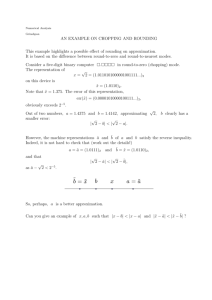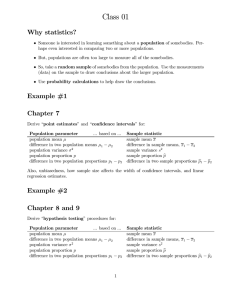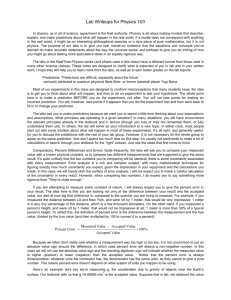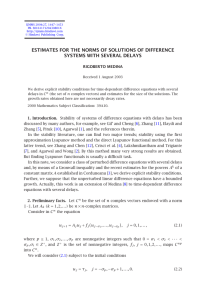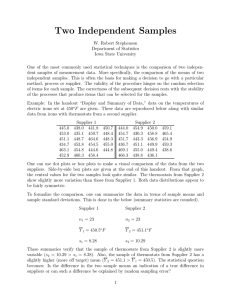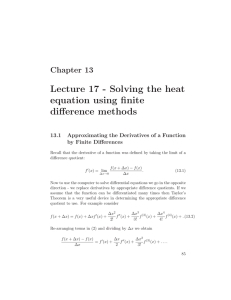SEMIDISCRETE CENTRAL DIFFERENCE METHOD IN TIME FOR DETERMINING SURFACE TEMPERATURES
advertisement
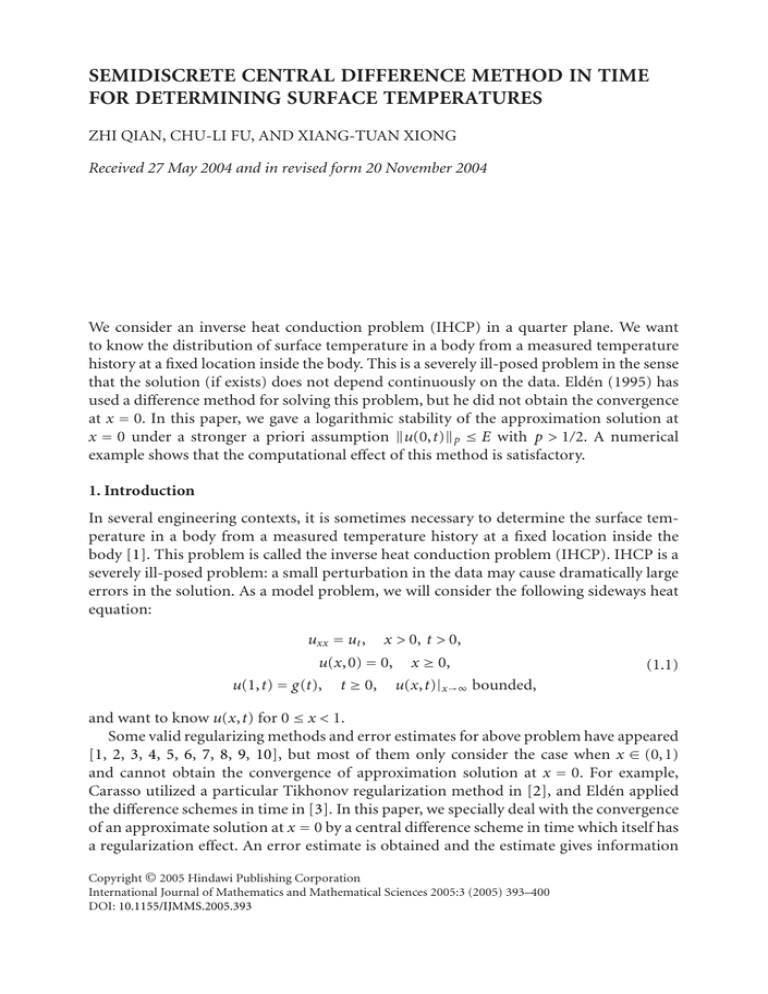
SEMIDISCRETE CENTRAL DIFFERENCE METHOD IN TIME
FOR DETERMINING SURFACE TEMPERATURES
ZHI QIAN, CHU-LI FU, AND XIANG-TUAN XIONG
Received 27 May 2004 and in revised form 20 November 2004
We consider an inverse heat conduction problem (IHCP) in a quarter plane. We want
to know the distribution of surface temperature in a body from a measured temperature
history at a fixed location inside the body. This is a severely ill-posed problem in the sense
that the solution (if exists) does not depend continuously on the data. Eldén (1995) has
used a difference method for solving this problem, but he did not obtain the convergence
at x = 0. In this paper, we gave a logarithmic stability of the approximation solution at
x = 0 under a stronger a priori assumption u(0,t) p ≤ E with p > 1/2. A numerical
example shows that the computational effect of this method is satisfactory.
1. Introduction
In several engineering contexts, it is sometimes necessary to determine the surface temperature in a body from a measured temperature history at a fixed location inside the
body [1]. This problem is called the inverse heat conduction problem (IHCP). IHCP is a
severely ill-posed problem: a small perturbation in the data may cause dramatically large
errors in the solution. As a model problem, we will consider the following sideways heat
equation:
uxx = ut ,
x > 0, t > 0,
u(x,0) = 0,
u(1,t) = g(t),
t ≥ 0,
x ≥ 0,
(1.1)
u(x,t)|x→∞ bounded,
and want to know u(x,t) for 0 ≤ x < 1.
Some valid regularizing methods and error estimates for above problem have appeared
[1, 2, 3, 4, 5, 6, 7, 8, 9, 10], but most of them only consider the case when x ∈ (0,1)
and cannot obtain the convergence of approximation solution at x = 0. For example,
Carasso utilized a particular Tikhonov regularization method in [2], and Eldén applied
the difference schemes in time in [3]. In this paper, we specially deal with the convergence
of an approximate solution at x = 0 by a central difference scheme in time which itself has
a regularization effect. An error estimate is obtained and the estimate gives information
Copyright © 2005 Hindawi Publishing Corporation
International Journal of Mathematics and Mathematical Sciences 2005:3 (2005) 393–400
DOI: 10.1155/IJMMS.2005.393
394
Semidiscrete central difference method
about how to choose the step length in the time discretization. A numerical example is
also given.
As we consider the problem (1.1) in L2 (R) with respect to the variable t, we extend
the domain of definition of the function u(x, ·), g(·) := u(1, ·), f (·) := u(0, ·) and other
functions appearing in the paper to the whole real t-axis by defining them to be zero for
t < 0. The notation · denotes L2 -norm, and
1
h(ξ)
:= √
2π
∞
−∞
e−iξt h(t)dt
(1.2)
is the Fourier transform of function h(t). We assume that there exists a priori bound for
f (t) := u(0,t):
f p ≤ E,
p ≥ 0,
(1.3)
where · p denotes the norm in H p (R) defined by
f p :=
∞
−∞
1+ξ
2 p 2
f (ξ) dξ
1/2
.
(1.4)
Let g(t) and gδ (t) denote the exact and measured data at x = 1 of the solution u(x,t),
respectively, which satisfy
g(t) − gδ (t) ≤ δ,
(1.5)
where δ is the measurement error. The solution of problem (1.1) has been given in [2] by
1
2π
u(x,t) = √
∞
−∞
eiξt e(1−x)θ(ξ) g(ξ)dξ,
0 ≤ x < 1,
(1.6)
or, equivalently,
u(x,ξ) = e(1−x)θ(ξ) g(ξ),
0 ≤ x < 1,
(1.7)
where θ(ξ) is the principal value of iξ:
θ(ξ) = (1 + σi)
|ξ |
2
,
σ = sign(ξ), ξ ∈ R.
(1.8)
It is easy to see from (1.7) that
f(ξ) = eθ(ξ) g(ξ).
(1.9)
Since the real part of θ(ξ) is nonnegative, u(x,ξ) is in L2 (R), so from (1.7) we know
that g(ξ) must decay rapidly as ξ → ∞. Small errors in high-frequency components can
blow up and completely destroy the solution for 0 ≤ x < 1. As the measured data gδ (t), its
Fourier transform gδ (ξ) is merely in L2 (R). In order to obtain the stability of the solution,
a central difference scheme in time, which we learned from Eldén [3], is considered in the
next section and an error estimate is obtained.
Zhi Qian et al. 395
2. The central difference schemes and error estimate
In this section, we will first consider discretization in time by central difference and then
discuss the error estimate. As an approximation of problem (1.1) we now consider the
following problem:
vxx (x,t) =
1
v(x,t + k) − v(x,t − k) ,
2k
v(x,0) = 0, x ≥ 0,
v(1,t) = gδ (t),
x > 0, t > 0,
(2.1)
t ≥ 0,
v(x,t)|x→∞ bounded,
where we have replaced the time derivative by a central difference with step length k. The
advantage of not discretizing in the space variable is that we can use Fourier transform
techniques.
By taking the Fourier transform for variable t in (2.1) we have
sinkξ
v(x,ξ),
k
v(1,ξ) = gδ (ξ),
vxx (x,ξ) = i
(2.2)
v(x,ξ)|x→∞ bounded.
The solution of (2.2) has been given in [3]:
v(x,ξ) = e(1−x)ρ(k,ξ) gδ (ξ),
(2.3)
or, equivalently,
1
v(x,t) = √
2π
∞
−∞
eiξt e(1−x)ρ(k,ξ) gδ (ξ)dξ,
0 ≤ x < 1,
(2.4)
where ρ(k,ξ) is the principal value of i((sinkξ)/k):
ρ(k,ξ) = (1 + νi)
| sinkξ |
2k
,
ν = sign(sinkξ), ξ ∈ R.
(2.5)
We will discuss the convergence and error estimate of approximation solution v(x,t) at
x = 0.
Theorem 2.1. If p > 1/2, and conditions (1.3), (1.5) hold, functions u(x,t) and v(x,t) are
given by (1.6), (2.4), respectively. Let
1
k = −2p 2 .
E
E
2 ln
ln
δ
δ
(2.6)
396
Semidiscrete central difference method
Then, there holds
u(0, ·) − v(0, ·) ≤ E
√
−2p
ln
E
δ
+ε ,
(2.7)
√
where ε = max{2k p ,( 2/6)k p−1/2 ,( 2/6)k2 }.
Proof. By (1.7), (2.3), and Parseval formula, we have
u(0, ·) − v(0, ·) = u
(0, ·) − v(0, ·) = eθ(ξ) g(ξ) − eρ(k,ξ) gδ (ξ).
(2.8)
For abbreviation, we denote, for example,
θ := θ(ξ),
g := g(ξ),
ρ := ρ(k,ξ),
(2.9)
Then, (1.9), (1.3), and (1.5) lead to
u(0, ·) − v(0, ·) = eθ g − eρ gδ = eθ g − eρ g + eρ g − eρ gδ ≤ 1 − eρ−θ f + eρ g − gδ − p/2 p/2 ρ 1 + ξ2
f + e g − gδ = 1 − e ρ −θ 1 + ξ 2
(2.10)
≤ sup A(ξ)E + sup B(ξ)δ,
ξ ∈R
ξ ∈R
where
A(ξ) := 1 − eρ−θ 1 + ξ 2
− p/2 ,
B(ξ) := eρ .
(2.11)
We start by estimating the second term of the right side of (2.10). From (2.5) and (2.6)
we know
sup B(ξ)δ = sup eRe(ρ) δ = sup e
ξ ∈R
ξ ∈R
√
| sin kξ |/2k
ξ ∈R
δ≤e
√
1/2k
δ = ln
E
δ
−2p
E.
(2.12)
To estimate the first term of the right side of (2.10), we rewrite A(ξ) as
A(ξ) = 1 − e−τ 1 + ξ 2
− p/2
,
(2.13)
Zhi Qian et al. 397
where
1 + σi 1 + νi | sinkξ |
|ξ | − √
τ = θ−ρ = √
k
2
2
1/2
.
(2.14)
Denote
E
1
E
ln
ξ0 := = 2 ln
k
δ
δ
−2p 2
.
(2.15)
We now estimate A(ξ) for large values of ξ, that is, for |ξ | ≥ ξ0 . Note that Re(τ) ≥ 0 and
by (2.13), we have
−p
A(ξ) ≤ 2|ξ |− p ≤ 2ξ0 = 2k p
(2.16)
A(ξ)E ≤ 2k p E.
(2.17)
so that
It remains to estimate A(ξ) for |ξ | < ξ0 , that is, |kξ | < 1. We now observe that for ξ in this
interval, σ = sign(ξ) = sign(sinkξ) = ν, which means that we can rewrite (2.14) as
1 τ1 = √
|kξ | − | sinkξ | .
2k
τ = τ1 (1 + σi),
Since τ1 ≥ 0, using inequalities
e− y ≤ y (y ≥ 0), we get
√
(2.18)
√
sina2 ≥ a2 − a6 /6 ≥ a(1 − a4 /6) (0 ≤ a < 1) and 1 −
1 − e−τ = 1 − e−iστ1 + e−iστ1 − e−(τ1 +iστ1 ) ≤ 1 − e−iστ1 + 1 − e−τ1 √
στ1 2 −1/2
−τ 1 ≤ 2τ1 ≤
|kξ |5/2 .
k
= 2 sin
+ 1−e
2
(2.19)
6
Combining this estimate with (2.13), we know
√
A(ξ) ≤
− p/2
2 −1/2
.
k |kξ |5/2 1 + ξ 2
6
(2.20)
If 1/2 < p < 5/2, from (2.20) we have
√
√
2 −1/2
2 p−1/2
|kξ |5/2 |ξ |− p E =
|kξ |5/2− p E
k
k
A(ξ)E ≤
6
6
√
2 p−1/2
≤
E for |kξ | < 1.
k
6
(2.21)
If p ≥ 5/2, for |ξ | ≥ 1, from (2.20) we have
√
√
2 −1/2
2 2 5/2− p
k
k |ξ |
|kξ |5/2 |ξ |− p E =
E
6
6
√
2 2
≤
k E for |kξ | < 1, |ξ | ≥ 1.
6
A(ξ)E ≤
(2.22)
398
Semidiscrete central difference method
For |ξ | < 1, from (2.20) we have
√
A(ξ)E ≤
√
2 −1/2
2 2
|kξ |5/2 E ≤
k
k E
6
6
for |kξ | < 1, |ξ | < 1.
(2.23)
Summarizing (2.17), (2.20), (2.21), (2.22), and (2.23), we know
√
√
1
2 p−1/2 2 2
,
k
k E =: εE −→ 0 for δ −→ 0, p > .
A(ξ)E ≤ max 2k ,
6
6
2
p
(2.24)
Combining (2.24) with (2.12), we have
u(0, ·) − v(0, ·) ≤ E
−2p
ln
E
δ
+ε .
(2.25)
This is just the estimate (2.7).
It is obvious that
1
lim u(0, ·) − v(0, ·) = 0 for p > .
2
δ →0
(2.26)
Theorem 2.1 solves the convergence of approximation solution v(x,t) of problem (1.1)
at x = 0, which is just the problem left over by Eldén in [3].
3. A numerical example
It is easy to verify that the function
2
x + 1 exp − (x + 1) ,
u(x,t) = t 3/2
0,
4t
t > 0,
(3.1)
t ≤ 0,
is the exact solution of problem (1.1) with data
2 exp − 1 ,
t
g(t) = t 3/2
t > 0,
t ≤ 0.
0,
(3.2)
So
f (t) := u(0,t) = t −3/2 exp −
1
.
4t
(3.3)
Figures 3.1 and 3.2 give a comparison of the exact solution u(0,t) with its approximation v(0,t) for p = 2/3 and p = 1, respectively. To obtain the solution v(0,t) of problem
(2.1) we applied the “method of lines” in [4]. The step length k is chosen according to
(2.6), and we get the measured data gδ (t) by adding random errors of amplitude δ to
g(t). It can be seen from these figures that the computation effect of the method given in
this paper is satisfactory.
Zhi Qian et al. 399
3.5
3
2.5
2
u
1.5
1
0.5
0
−0.5
0
0.1 0.2 0.3 0.4 0.5 0.6 0.7 0.8 0.9
1
t
Approximation
Exact solution
Figure 3.1. x = 0, p = 2/3, δ = 10−4 , E = 6, k = 1/122.
3.5
3
2.5
2
u
1.5
1
0.5
0
−0.5
0
0.1 0.2 0.3 0.4 0.5 0.6 0.7 0.8 0.9
1
t
Approximation
Exact solution
Figure 3.2. x = 0, p = 1, δ = 10−5 , E = 12, k = 1/152.
Acknowledgment
This project is supported by the National Natural Science Foundation of China (no.
10271050) and the Natural Science Foundation of Gansu Province of China (no. ZS021A25-001-Z).
400
Semidiscrete central difference method
References
[1]
[2]
[3]
[4]
[5]
[6]
[7]
[8]
[9]
[10]
J. V. Beck, B. Blackwell, and C. R. Clair, Inverse Heat Conduction. Ill-Posed Problems, John Wiley
& Sons, New York, 1985.
A. Carasso, Determining surface temperatures from interior observations, SIAM J. Appl. Math.
42 (1982), no. 3, 558–574.
L. Eldén, Numerical solution of the sideways heat equation by difference approximation in time,
Inverse Problems 11 (1995), no. 4, 913–923.
, Solving the sideways heat equation by a “method of lines,” J. Heat Trans. ASME. 119
(1997), 406–412.
L. Eldén, F. Berntsson, and T. Regińska, Wavelet and Fourier methods for solving the sideways
heat equation, SIAM J. Sci. Comput. 21 (2000), no. 6, 2187–2205.
C. L. Fu and C. Y. Qiu, Wavelet and error estimation of surface heat flux, J. Comput. Appl. Math.
150 (2003), no. 1, 143–155.
C. L. Fu, C. Y. Qiu, and Y. B. Zhu, A note on: “Sideways heat equation and wavelets” and constant
e∗ , Comput. Math. Appl. 43 (2002), no. 8-9, 1125–1134.
D. N. Hào, H.-J. Reinhardt, and A. Schneider, Numerical solution to a sideways parabolic equation, Internat. J. Numer. Methods Engrg. 50 (2001), no. 5, 1253–1267.
C.-Y. Qiu, C.-L. Fu, and Y.-B. Zhu, Wavelets and regularization of the sideways heat equation,
Comput. Math. Appl. 46 (2003), no. 5-6, 821–829.
T. I. Seidman and L. Eldén, An “optimal filtering” method for the sideways heat equation, Inverse
Problems 6 (1990), no. 4, 681–696.
Zhi Qian: Department of Mathematics, Lanzhou University, Lanzhou 730000, China
E-mail address: qianzh03@st.lzu.edu.cn
Chu-Li Fu: Department of Mathematics, Lanzhou University, Lanzhou 730000, China
E-mail address: fuchuli@lzu.edu.cn
Xiang-Tuan Xiong: Department of Mathematics, Lanzhou University, Lanzhou 730000, China
E-mail address: xiongxt04@st.lzu.edu.cn

